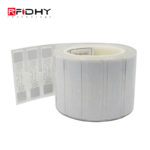A vivid Video show to explain why Smart RFID Label Tag are more frequently used in Bulk Storage other than Bar-code Label
In warehouses, distribution centers, and facilities that have deployed automated inventory management technology, barcode labels have become standard operating procedures. But RFID has become a bigger part of the inventory management equation, especially in retail where a number of large companies are using the tags to track goods at the pallet, case, and even item-level at the retail shelf. While RFID has some big advantages over barcode labels, deciding whether to use the technology in your own inventory operations will require weighing the costs and benefits.
 RFID does not require line of sight for scanning. With barcode labels, employees (or fixed position scanners) have to be able to see the label in order to get a reliable scan. In conveyor-based operations, that means boxes have to be oriented a certain way on the belt so that the label can be scanned. Because RFID tags can be read from any orientation, it can speed up the scanning process and reduce the labor associated with repositioning boxes for scanning. Also, scanners can read multiple tags at the same time, so an entire pallet-load of items can be scanned simultaneously.
RFID does not require line of sight for scanning. With barcode labels, employees (or fixed position scanners) have to be able to see the label in order to get a reliable scan. In conveyor-based operations, that means boxes have to be oriented a certain way on the belt so that the label can be scanned. Because RFID tags can be read from any orientation, it can speed up the scanning process and reduce the labor associated with repositioning boxes for scanning. Also, scanners can read multiple tags at the same time, so an entire pallet-load of items can be scanned simultaneously.
– RFID can reduce labor costs. Labor can account for 50% to 80% of costs in a distribution center. With RFID, inventory check-in, regularly inventory counts, picking/pack times, and shipment verification can all be done in seconds or minutes. Processes that used to require multiple employees to complete can be handled automatically with a few scans.
– RFID also improves visibility of inventory by providing real-time updates and faster scanning. With RFID readers placed at each portal or doorway, you can know exactly when inventory enters or leaves a location; with barcodes, employees could potentially move an item without scanning it, which erodes data accuracy. That visibility can also improve the tracking of returns or recalled items by providing real-time updates as the goods re-enter the facility.
– For companies that use returnable containers or pallets, RFID provides a way to track those items across the supply chain, optimize asset inventory, and reduce loss or theft. Returnable containers can represent millions of dollars in capital investments, so RFID provides a way to reduce those expenses.
– Traditional linear barcodes can only hold a limited amount of data, typically a serial number that references a database. RFID tags can hold larger amounts and different types of data, and that data can be read even in remote locations without a connection to the back-end database.
– Durability also increases with RFID tags. Barcode labels can fade or fall off when they are exposed to the weather, sunlight, or other harsh conditions. RFID tags now exist that are not only weatherproof, but that can also survive harsh chemical baths or even multiple autoclave and sterilization cycles.





